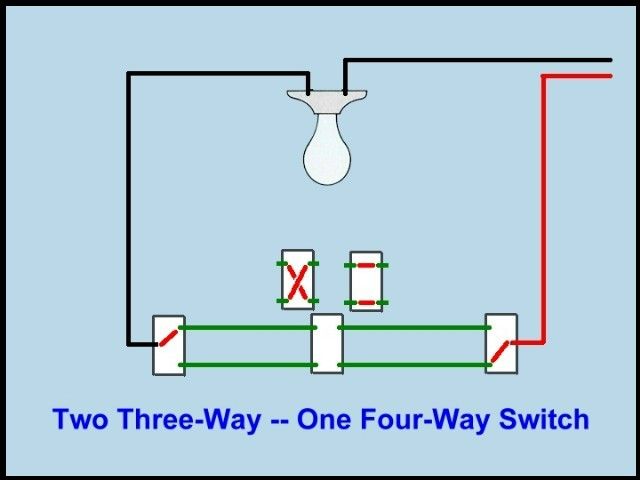Operating one light with multiple switches is a common requirement in home and commercial electrical systems. Using 3 switches to control a single light allows convenient control from multiple locations, like at the top and bottom of a staircase, or at multiple entrances to a room. While it may seem complex at first, this can be achieved in a straightforward way by properly wiring the switches together.
Page Contents
Basic Electrical Concepts
To understand how multiple switches can operate one light, we first need to cover some basic electrical concepts:
- A light fixture connects to a hot wire that provides power, and a neutral wire that completes the circuit back to the electrical panel.
- A standard single pole switch simply connects or disconnects the hot wire to turn the light on and off.
- A three way switch has three terminals – common, traveler 1, and traveler 2. Power comes in the common terminal, and connects to one traveler terminal when the switch is toggled one way, and the other traveler terminal when toggled the other way.
- The traveler wires run between the switches, allowing them to communicate their on/off state.
Wiring Setup
For 3 switches to control 1 light, the basic wiring setup is:
- The power source connects to the common terminal on one 3-way switch.
- The light fixture hot wire connects to the common terminal on the other 3-way switch.
- The traveler wires run between the traveler terminals on the two 3-way switches.
- The neutral from the light connects back at the fixture.
This allows either switch to connect or disconnect the hot wire to the light fixture, because flipping either switch changes the state of the traveler wires to connect different terminals.
Detailed Wiring Diagram
Here is a detailed wiring diagram showing how 3 switches can control 1 light:
| Component | Connection |
| Power source hot wire | 3-way Switch 1 Common |
| 3-way Switch 1 Traveler 1 | 3-way Switch 2 Traveler 1 |
| 3-way Switch 1 Traveler 2 | 3-way Switch 3 Traveler 2 |
| 3-way Switch 2 Common | Light Fixture Hot Wire |
| 3-way Switch 2 Traveler 1 | 3-way Switch 3 Traveler 1 |
| 3-way Switch 3 Common | Not connected |
| Light Fixture Neutral | Neutral Wire |
Following this wiring allows all 3 switches to independently control the light by changing the connections between the traveler wires.
Dimmer Switches
Dimmer switches can also be used in this 3 switch 1 light configuration. Instead of simply toggling the hot wire on and off, the dimmer switches vary the brightness of the light.
Dimmers have 4 terminals – common, traveler 1, traveler 2, and a neutral. The wiring is similar to the standard toggle switches, except the dimmer neutral terminals connect to the neutral wire instead of capped off.
Four-Way Switch Wiring
For more than 3 switches controlling 1 light, you can use 4-way and intermediate switches in addition to the two 3-way switches.
- Add a 4-way switch at each new switch location between the existing 3-ways.
- Wire all the 4-way common terminals together with the traveler wires.
- Connect the 4-way traveler terminals to the traveler wires from the 3-ways.
Following this expanding switching ladder pattern allows an unlimited number of switches to control one light fixture.
Troubleshooting Tips
If you wire multiple switches incorrectly, issues like the light not turning on, switches operating incorrectly, or dimmers not dimming can occur. Here are some troubleshooting tips:
- Use a multimeter to check for voltage at each switch to isolate the problem.
- Verify the common and traveler wires are connected to the correct switch terminals.
- Check that the neutral wire is connected in dimmer switches.
- Confirm that the hot source wire only connects to one common terminal.
- Re-check for any loose wire connections or mismatches.
Smart Light Switch Considerations
Smart switches like WiFi light switches can also be integrated into a 3 switch 1 light configuration. However, there are some specific wiring requirements to ensure proper operation:
- Only one smart switch can be installed in a 3-way circuit.
- The smart switch should replace one of the existing standard 3-way switches.
- A companion or remote switch is required at the other switch locations.
- The companion switch allows the WiFi switch to remain in contact with the traveler wires.
This allows you to get smart switch features like app control, schedules and automation triggers, while keeping multi-location physical control.
Conclusion
Operating one light fixture from multiple switches is convenient in many home and commercial applications. While it requires more complex wiring with 3-way, 4-way, and intermediate switches, following the basic traveler wire communication concept allows you to add as many switch locations as needed. Paying close attention to the wiring diagram, proper switch terminal connections, and troubleshooting basics will allow you to successfully configure multi-switch control for any single light in your environment.
